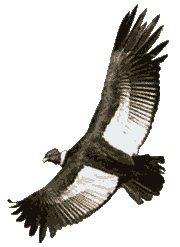General information:
Andean Condors live in groups of three or more consisting of an equal
number of males, and related females and their offspring. In
the wild, hunting is usually done by scavenging, feeding in groups.
Vultur
gryphus is the only bird species in which social feeding is routine.
Condors are very finicky eaters. They don't rush into their meals all
at once. In the wild, Condors have been known to wait as long as five days
before eating a meal, even when it`s set right in front of them.
In captivity, in order to preserve the Condors' nutritional health the
birds are always fed by the same keeper.

